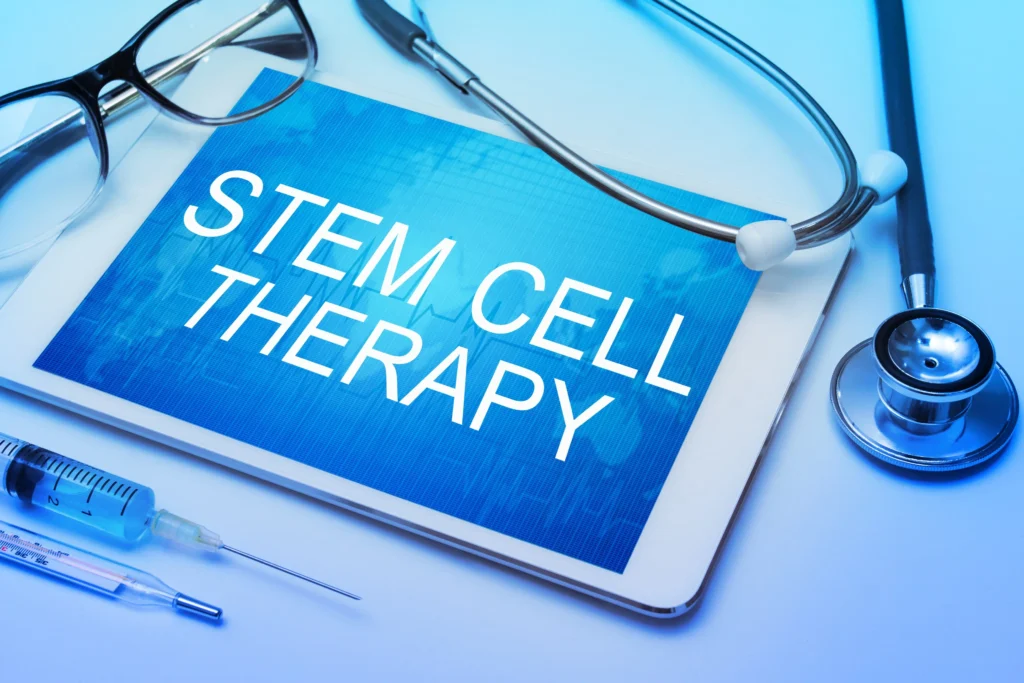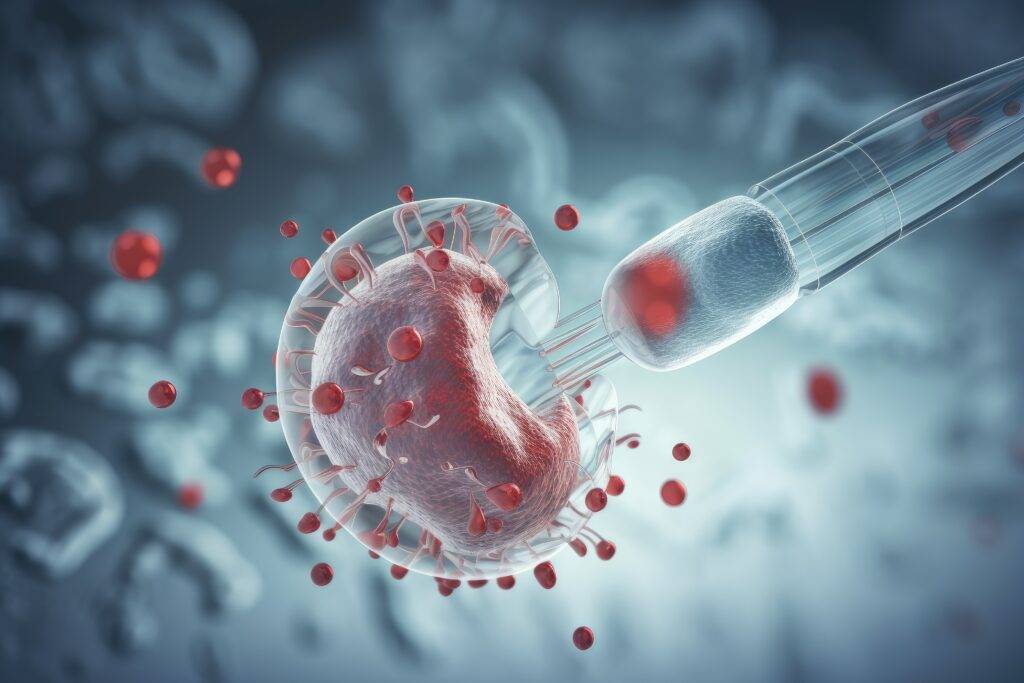Bone Marrow-Derived Stem Cells (BMAC) — Harnessed and Refined through the SIGMA SynerG™ Process to Regenerate Joint and Tendon Health.
Alpha-2 Macroglobulin (A2M) & Protease Inhibitor Therapy — a key pillar of the SIGMA SynerG™ Orthobiologics Suite


✅ Moderate osteoarthritis (knee, shoulder, hip)
✅ Rotator cuff or labral tears unresponsive to PRP
✅ Chronic tendon or ligament injuries (Achilles, patellar, UCL)
✅ Athletes pursuing joint-preserving solutions

In the SIGMA SynerG™ Suite, Bone Marrow Cells work in harmony with Platelet-Rich Plasma (PRP), A2M protease inhibitors, and Adipose-Derived Stem Cells.
Each targets a different axis of healing
— BMAC provides the cellular engine, while A2M and PRP modulate the inflammatory environment.

Experience a data-driven, outcome-based approach to stem-cell regenerative medicine with Dr Frank McCormick.
Bone marrow-derived stem cells (BM-MDSC) are multipotent stem cells that can differentiate into several types of cells, including osteoblasts (bone-forming cells), chondrocytes (cartilage cells), and adipocytes (fat cells) (1). They are commonly found in the bone marrow and have been known to aid in the recovery of bone after an injury (1).
Image retrieved from: https://allcells.com/clinical-applications-of-bone-marrow-derived-mesenchymal-stem-cells/
These cells may be induced to replicate along any particular cell line when exposed to the right stimulation and conditioning environments. BM-MDSCs can be derived from perivascular cells (pericytes in adult tissues). They can be injected into a variety of tissues that are prone to sports-related injuries (2).
Figure 1: Fate of pericyte
Adapted from: Singh J, O Onimowo J, S Khan W. Bone marrow derived stem cells in trauma and orthopaedics: a review of the current trend. Current stem cell research & therapy. 2015 Jan 1;10(1):37-42.
In recent years, there has been an increasing interest in using bone marrow-derived stem cells (BMSCs) in orthopedic surgery (3). There are several potential benefits of using BMSCs including the ability to repair damaged tissue, regenerate lost tissue, and improve healing time (4). They promote osteogenic and chondrogenic, tenogenic, adipogenic, and myocyte differentiation and nerve regeneration.(5) Additionally, BMSCs are safe and effective in animal models and human clinical trials.
TECHNIQUE
There are many ways to harvest bone marrow, but the most common is through needle aspiration. A needle is inserted into the hip bone and marrow is suctioned out with a syringe (6). The entire process takes about 30 minutes. Once the marrow is collected, it is then processed to remove any impurities (6). The stem cells are then isolated and concentrated before being injected into the affected joint or area of injury (6). The entire process from start to finish takes about 2-3 weeks.
RESULTS
Bone marrow-derived stem cells (BMSCs) have been investigated for their potential use in orthopedic applications for many years (7). They are used to treat joint degeneration, tendon and ligament injuries, and non-union fractures (7).
OSTEOGENIC DIFFERENTIATION
To increase absorption of the graft materials, bone marrow stem cells (MSCs) from the iliac crest are directly infused into them (8). Signals may be produced in vitro to cause MSCs to develop into the bone using a tri-phasic pathway. First, BM-MDSCs multiply, followed by an increase in the expression of alkaline phosphatase, which causes the synthesis of osteopontin and osteocalcin and, ultimately forming bone (9).
BM-MDSCs are either coupled with bone morphogenetic protein and implanted at the necessary place, or they are directly incorporated into synthetic or natural bone grafts (10). For the treatment of posttraumatic long bone deformities, MSC is used in conjunction with three-dimensional scaffolds to give mechanical support and stability. In their investigation, Howitz et al. employed the BM MSCs of identical twins to treat osteogenesis imperfecta, with encouraging preliminary and ongoing outcomes (11).
In one study, patients with severe knee osteoarthritis who received a single injection of BMSCs showed significant improvements in pain and function compared to those who received a placebo injection (12). In another study, patients with Achilles tendon rupture who received surgery plus BMSC injections had better outcomes than those who just received surgery (13). The use of BMSCs in orthopedics is still in the early stages, but the results so far are encouraging. It is possible that BMSCs could eventually be used to treat a wide range of orthopedic conditions with minimal side effects.
The study found that bone marrow-derived stem cells can improve the healing of various orthopedic injuries, including those of the spine, hip, and knee (14). The researchers believe that these cells may help to repair and regenerate damaged tissue, as well as reduce inflammation. Additionally, the study found that the use of bone marrow-derived stem cells is safe and well-tolerated in patients (14).
CHONDROGENIC DIFFERENTIATION
In animal models, autologous MSC cell treatment has been proven to lessen cartilage degradation and stop post-traumatic arthritis (15). Patients who received engineered bone marrow-derived MSCs seeded on collagen scaffold showed superior repair of femoral and patellar lesions than the collagen-free control group ,according to Wakitani et al (16). Another study by Shetty et al. found that three years after biological arthroplasty, the functional score had improved and discomfort levels had decreased (17).
TENOGENIC DIFFERENTIATION
It has been demonstrated that BM-MDSCs enhance bone tunnel tendon graft osteointegration (18). Even 4 weeks after surgery, Awad et al. noted improved biomechanical qualities (19). Type III collagen, which has less tensile strength and more flexibility, is more prevalent in repair tissue.
MYOCYTE DIFFERENTIATION AND NERVE REGENERATION
BM- MSCs have demonstrated a promising role in the treatment of chronic skin wounds and ischemic limbs (20). They move to the location of the skeletal damage through the bloodstream (21). These stem cells were absorbed with noteworthy myogenesis in mouse models. MSCs have also demonstrated a role in peripheral nerve healing (21).
ADIPOGENIC DIFFERENTIATION
Although adipose tissue engineering is still in its infancy, investigations have revealed that brown adipocytes and skeletal muscle have common ancestors. There are two forms of adipose tissue: white and brown, which perform endocrine and energy reserve functions, respectively, in the body (22). Additionally, brown fat is considered to be very insulin-sensitive and aids in controlling body temperature.
RECOVERY
The duration of a stem cell transplant ranges from 30 minutes to 4 hours (23). Due to the high dose of chemotherapies before a stem cell transplant, infections are frequently experienced (24). With an allogeneic transplant, there is also a chance that new stem cells won’t engraft (24). In general, autologous transplant recovery takes three to six months, while allogeneic transplant recovery takes twelve to eighteen months (25).
RESULTS
Stem cells have been used in regenerative medicine to treat a variety of orthopedic conditions including arthritis, bone injuries, and osteoarthritis
(15). Regenerative medicine with stem cells is a promising field with applications in sports medicine, orthopedics, and dentistry. The use of adipose-derived stem cells in regenerative medicine is expected to increase as the ease of harvesting and ability to differentiate into other cell types is further explored
(16).
ARTHRITIS
Arthritis is a degenerative disease of the joints characterized by inflammation, pain, and limited mobility
(17). ASCs have been investigated as a possible treatment for arthritis due to their anti-inflammatory and immunomodulatory properties.
BONE INJURIES
Bone injuries such as bone fractures and post-traumatic bone defects can be treated with ASCs
(18). ASCs have been shown to promote bone repair through a variety of different mechanisms including direct differentiation into bone cells and secretion of growth factors
(19).
OSTEOARTHRITIS
Osteoarthritis is a degenerative joint disease characterized by the breakdown of cartilage in the joints
(20). ASCs can be applied to treat osteoarthritis due to their ability to differentiate into chondrocytes and release cartilage growth factors.
LIMB LENGTHENING USING ASCS
Limb lengthening is a surgical procedure in which a section of bone is surgically broken and then allowed to heal in a shortened position followed by a regimen of daily bone growth-stimulating injections
(21). ASCs have been investigated as a regenerative agent in limb lengthening due to their high proliferation rate and differentiation capability into bone cells
(21). In limb lengthening, ASCs are injected into the shortened bone to induce new bone growth that will ultimately facilitate the lengthening of the limb
(22). The injected ASCs will differentiate into bone cells that will contribute to the lengthening of the bone by creating a new bone matrix.
UTILIZATION OF ASCS FOR BONE REGENERATION
ASCs have been investigated as a possible treatment for patients with osteoporosis due to the ability of autologous ASCs to differentiate into bone cells
(23). Studies have shown that ASCs can be genetically modified to produce large amounts of the cytokine, bone morphogenetic protein-2 (BMP-2), which promotes bone growth
(23). These genetically modified ASCs are an attractive option for the treatment of osteoporosis as they are autologous and can be easily harvested from the patient.
RECOVERY
About 10-15% of people report recovery within a few weeks of the use of ASC, but the majority have some reduction in pain, edema, and inflammation within six weeks
(24). The development of reparative tissue can require 4-6 months. ASCs allow us to resume our normal activities afterward with far less recovery time than anticipated from common cartilage, joint, or spinal operations
(25).
